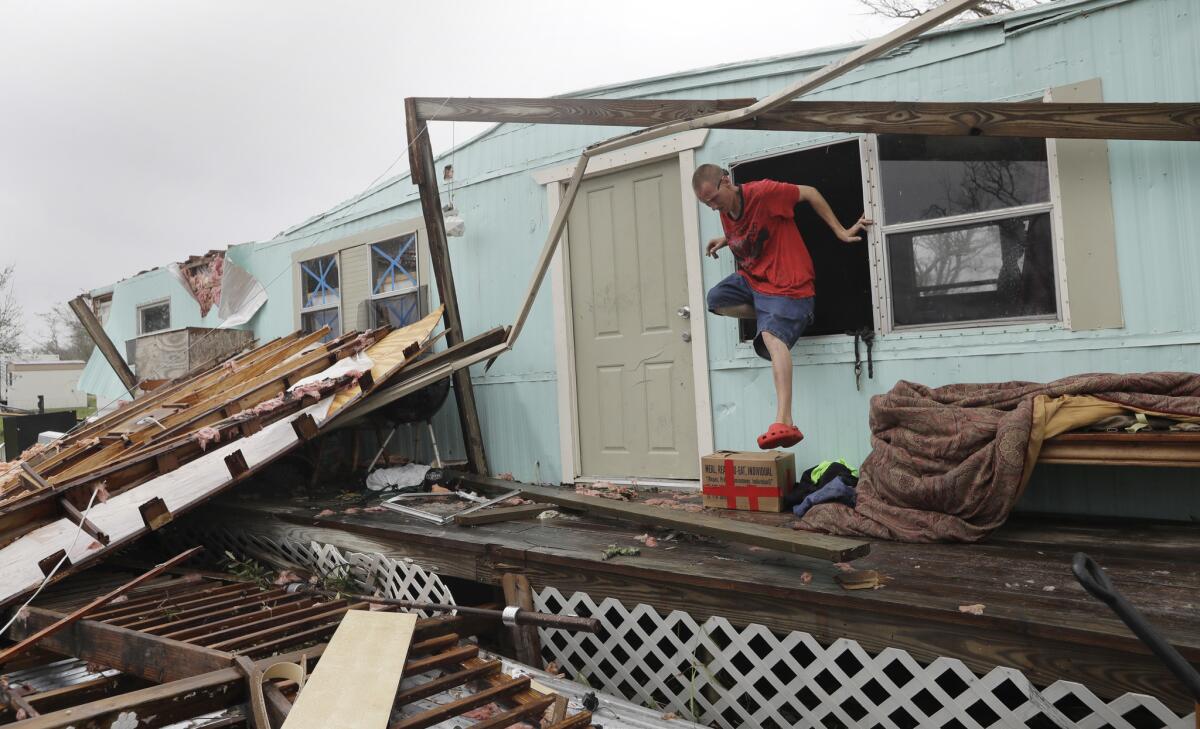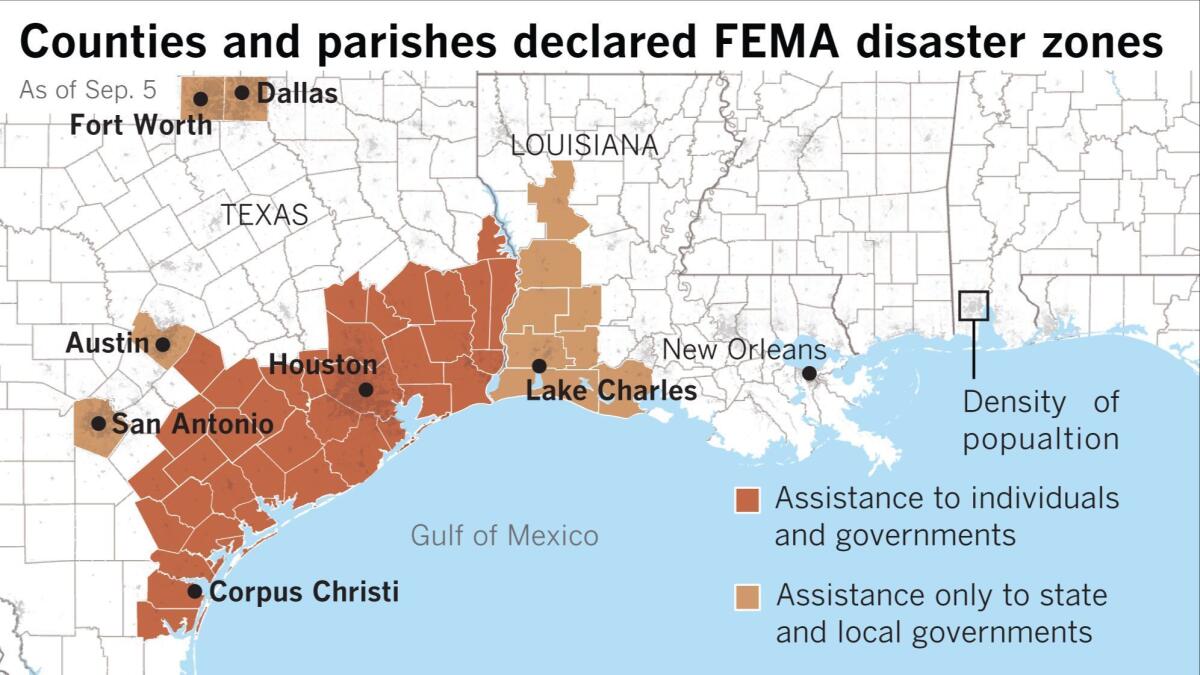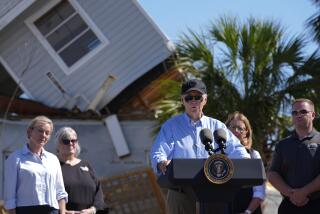Trump heads to Texas to witness destruction from Harvey as emergency teams race to rescue families

President Trump pledged his “full support” Monday to the tens of thousands of Americans displaced by the epic hurricane and flooding that has devastated parts of coastal Texas and Louisiana, warning that recovery from Harvey will be a “long and difficult road.”
In the short term, he told reporters in the East Room, “protecting the lives of our people is my highest priority. Every asset of my command is at the disposal of local officials.”
“We will get through this,” Trump added during a joint appearance with Finland’s visiting president, Sauli Niinistö. “We will come out stronger.”
He promised that Congress would move swiftly to approve long-term recovery funding. “We think you’re going to have what you need and it’s going to go fast,” he said.
Trump will visit the waterlogged city of Corpus Christi and other parts of Texas on Tuesday to witness the destruction from Tropical Storm Harvey, which was initially a hurricane. He said he may return to Texas and visit Louisiana later this week.
Trump almost certainly has visions of Hurricane Katrina, which overwhelmed New Orleans and the Gulf Coast 12 Augusts ago. President George W. Bush was seen as slow to react and his administration never recovered from the criticism.
Trump hopes to show himself as a leader of action and efficiency. But his visit poses its own potential problems. Law enforcement, medical and other emergency officials are often wary of diverting critical resources to presidential security and logistics while major relief operations are still underway.
Presidential visits require ordering hospitals on stand-by, closing air space and supplementing federal security detail with state and local officers.
Bush justified his Air Force 1 flyover inspection of the Katrina floods in 2005 by insisting that he did not want to distract from response and recovery efforts. He was pummeled for it.
Trump’s visit also may come under fire since his budget proposal to Congress has sought to slash funding for the Federal Emergency Management Agency that takes the lead role in responding to natural disasters like Harvey.
Asked whether it was wise to try to cut hundreds of millions of dollars for FEMA grants that help cities and states prepare for natural disasters, Trump estimated the rebuilding task from Harvey would cost billions of dollars, insisting that FEMA had little role in the long-term effort.

The timing of a presidential visit to a disaster zone is always subject to debate, according to Craig Fugate, the FEMA administrator under President Obama.
“You don’t want to get there too early and you don’t want to get there too late,” Fugate said in a telephone interview.
“When a president comes in, it does several things: It sends a message to the survivors and the nation that this is a large-scale event and the commitment of the administration is there to support the government response,” Fugate said.
Bush’s political plunge after Katrina demonstrates the degree to which Americans who might tune out other aspects of governing pay very close attention to a president’s behavior during a disaster.
Texas Gov. Greg Abbott told CBS that by going to Corpus Christi and steering clear of Houston, the worst-hit city, Trump “will not be getting into harm’s way or interrupting the evacuations or emergency response.”
Abbott praised the federal government’s “swift response,” grading it an “A plus” at a news briefing Monday. He said he had spoken with Trump several times, as well as with members of the Cabinet and administration, including the current FEMA head, William B. “Brock” Long, the acting secretary of Homeland Security, and top officials at the departments of health and human services, transportation and energy.
Trump’s administration is still riddled with vacancies, including key positions related to responding to natural disasters. Trump has yet to name a new secretary of Homeland Security since John F. Kelly left the post to become White House chief of staff. Elaine Duke is the acting secretary.
No one has been nominated to head the National Oceanic and Atmospheric Administration. The National Hurricane Center is searching for a director, and two nominees for deputy director at FEMA are awaiting confirmation.
“You know what? I don’t even have time to worry about it right now,” Long said Sunday on CNN’s “State of the Union” when asked about the empty offices. FEMA has “great lines of communications” with Trump, Long said, adding that the president is “extremely concerned, incredibly engaged.”
“Just because there’s not a leader in some of these areas, you have got some dedicated, highly knowledgeable, experienced workforce in each one of these agencies, and they know this mission,” Long said.
Trump also has faced criticism for announcing a series of controversial actions Friday night as the monster hurricane bore down on Texas.
Critics saw the timing as an attempt to bury debate over his pardon for Joe Arpaio, the former sheriff of Maricopa County, Ariz., who violated a federal court order against racial profiling; new restrictions on service by transgender individuals in the military; and the ousting of Sebastian Gorka, a hard-right national security advisor who appears often on television defending Trump.
Those issues were dwarfed by live images from Texas.
Trump’s appearance in Texas will guarantee he is a central part of the recovery as it progresses. The administration’s response in the months ahead will further define his tenure in a period in which one influential Republican, Sen. Bob Corker of Tennessee, who chairs the Foreign Relations Committee, has already questioned his competence for the job.
So far, Harvey does not look as if it will leave an effect on the scale of Hurricane Katrina. But the Trump administration will nonetheless benefit from lessons learned.
After Katrina, local and federal officials blamed each other for the botched response. FEMA directors had previously waited until a governor requested help before sending personnel and resources. That changed after Congress passed the Emergency Management Reform Act in 2006.
Now FEMA officials are free to start sending relief supplies and placing emergency personnel before a storm hits.
But when Texans begin rebuilding and evaluating Harvey’s impact, Trump could face scrutiny for his decision two weeks ago to revoke an Obama order that would have forced roads, bridges and other infrastructure projects to meet new flood-protection standards to meet the challenge of climate change.
Trump’s order was part of a broader push to reduce the time it takes to build such projects. Proponents of such regulations will point to the flooding in Texas in making the case that environmental regulations have real-world consequences.
Trump was conscious that his trip to Texas could cause disruption, tweeting Sunday morning that he would go only when he knew it would not alter the focus on “life and safety.”
But the storm also served as another test for Trump.
On Monday, Trump retweeted Abbott’s praise of the Texas National Guard. But earlier, Trump used his account to wade into controversies over the Arpaio pardon, retweeting a supporter who accused Obama of pardoning a traitor and a terrorist, and the racial violence in Charlottesville, Va., retweeting another supporter who argued that the left is fueling the unrest.
Twitter: @noahbierman
Twitter: @ByBrianBennett
ALSO
As death toll from Harvey continues to rise, Trump retweets take aim at Obama and the news media
How to help the victims of Tropical Storm Harvey
Red Cross braces for weeks of relief effort in the face of colossal storm disaster
More to Read
Sign up for Essential California
The most important California stories and recommendations in your inbox every morning.
You may occasionally receive promotional content from the Los Angeles Times.












